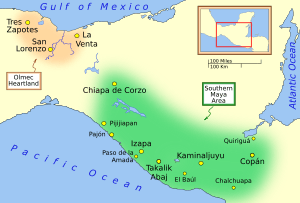Southern Maya area facts for kids

The Southern Maya Area (SMA) is a special part of Mesoamerica. Experts believe it was very important for the start of Maya civilization. This early period is also called the Preclassic Maya time.
This area stretches like a wide arc. It goes from Chiapa de Corzo in the northwest. From there, it reaches south to Izapa and Paso de la Amada. It also extends southeast to Copán, Honduras. Then, it goes south from Copán to Chalchuapa, El Salvador.
The Pacific Ocean forms the southern and western edges of the Southern Maya Area.
Contents
What is the Southern Maya Area?
The Southern Maya Area is a region where ancient cities grew. Many of these cities were built by people who spoke Maya languages. However, other groups also lived here. They spoke languages like Xinca, Lenca, Mixe–Zoquean, and Pipil. Because many different languages were spoken, calling it just the "Southern Maya Area" isn't perfectly accurate. It was a very diverse place!
Important Ancient Cities
Inside this area, you can find many important ancient centers. Some of the major sites include:
- Kaminaljuyu
- Takalik Abaj
- Chocolá
- El Sitio
- El Jobo
- La Blanca
- Ujuxte
- Palo Gordo
- El Baúl
- Cotzumalhuapa
- Monte Alto
- Semetabaj
- El Portón
- Zacualpa
- Zaculeu
- Balberta
- La Montana
Most of these cities grew very strong during the Preclassic period. This was before they declined or disappeared.
Early Discoveries in the Southern Maya Area
Many early communities were found along the Pacific Coast. These sites show how important the Southern Maya Area was from the very beginning.
Finding Ancient Pottery
One important site is La Victoria. Michael Coe, an archaeologist, studied this site. He found the first clear sequence of pottery from early Preclassic times. This helped experts understand how pottery changed over time.
Later, John E. Clark and other researchers continued this work. At sites like Paso de la Amada, they found even older pottery. This pushed back the timeline for early complex societies to around c. 2000 BC. This includes the first main centers, fancy pottery, small statues (figurines), and other signs of early complex culture in Mesoamerica.
Signs of Advanced Societies
The Southern Maya Area holds some amazing "firsts."
- Ballcourt: The oldest known ballcourt was found at Paso de la Amada. This was a place where ancient people played a special game.
- Ranked Society: Evidence of a ranked society was also found at Paso de la Amada. This was a rich child's burial. It showed that some people had more power or importance than others. This is a sign of early social classes.
- Maya Beliefs: Near Paso de la Amada, at La Blanca, archaeologists found a special shape called a quatrefoil. It was made of baked clay and buried near Mound 1. This mound was one of the largest and earliest temple mounds in Mesoamerica. The quatrefoil shows an early link to what later became important Maya beliefs and ideas.

